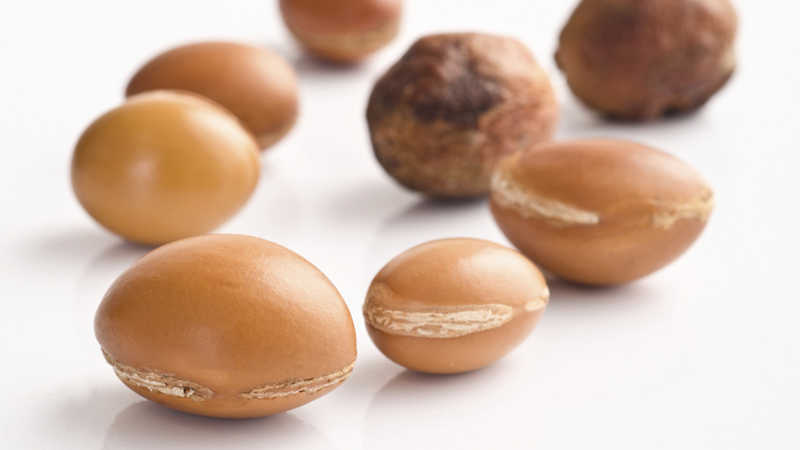Base oil of the month: Argan

The Argan tree (Argania spinosa), also known as Morocco Ironwood, is thought to have originated in the Moroccan village of Argana. The ancient species, believed to one of the few survivors of the Tertiary Period spanning 65 million to 1.8 million years ago, once covered North Africa but now only grows in south-west Morocco in an area covering 700,000 to 800,000 hectares. Due to declining numbers and various ecological problems the tree has been placed under UNESCO protection. The Arganeraie Biosphere Reserve was established in 1998 to help conserve the ecosystem, protect the tree from human exploitation and to promote sustainable use of natural resources. The UNESCO biosphere designation has limited the supply of Argan oil, making it one of the rarest and most expensive oils in the world.
The Argan tree
How is Argan oil produced
The benefits of Argan oil
- Argan oil is incredibly light, non-comedogenic (does not block pores) and is easily absorbed, to leave the skin feeling wonderfully moisturised, silky soft and smooth.
- It can help combat sun damage, wrinkles and fine lines by boosting elasticity and stimulating skin cell renewal. It can also help to reduce the appearance of scars and stretch marks.
- Argan oil nourishes, protects and moisturises dry, chapped, cracked, flaky and inflamed skin whilst protecting against infection. It can be particularly helpful for eczema and psoriasis and for soothing chapped lips. It can also be used with babies to help treat sore, dry patches and cradle cap.
- It can help regulate sebum production in oily skin, helping to prevent spots and excess oiliness. It also soothes the inflammation of acne and helps prevent scarring.
- It can help protect sensitive skins from allergens that may cause itchiness and inflammation.
- Helps repair and moisturise dry and damaged hair, restoring healthy condition and shine. It can also stimulate hair growth and soothe itchy, dry, scalps and dandruff.
- Also a great conditioner for the nails and cuticles. It can help to nourish and strengthen dry, brittle nails, soften the cuticles, promote healthy growth and restore natural shine.
- Argan’s anti-inflammatory properties can useful in massage blends to help to ease rheumatic joints, aching muscles and sports injuries, aches and pains.
Skin and haircare recipes using Argan oil
Argan Oil can be blended with other products but you may find that the absorption rate is reduced, which in turn will impact on the moisturising and healing effects. Remember a little goes a long way so you’ll only need a few drops!
Lightly Moisturising Facial Toner
Add 2ml Argan Oil to 100ml Rose Hydrolat. Spray liberally onto face as a moisturising “all in one” toner.
Ultimate Luxury Facial Oil
Take 50ml Argan Oil and add 2 drops Jasmine, 2 Rose, 4 Neroli and 8 Geranium. Shake bottle well and apply to face and neck every evening. Allow to sink in and then apply moisturiser as normal if required.
Hair Conditioner For Dry Frizzy Hair
Massage a few drops of Argan Oil into the palms of your hands and smooth on to dry, frizzy hair. Alternatively - add 2 drops Jasmine, 6 Ylang Ylang, 4 Geranium and 4 Sandalwood to 20ml Argan Oil. Shake well and massage into hair and scalp. Leave the oil on for a few hours and then wash as normal. This will help to nourish, strengthen, repair and protect the hair and give a more shiny, healthy appearance.
Safety Advice
If you suffer from nut allergies it is advisable to consult your doctor before using this product. Although it isn’t technically a tree nut, it is a stone fruit and the oil is derived from the kernel / nut. A small patch test should be performed to ensure there is no allergic reaction.
Joannah MetcalfeConsultant Aromatherapist




